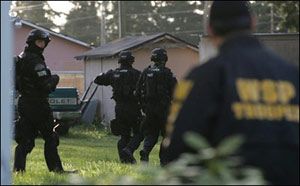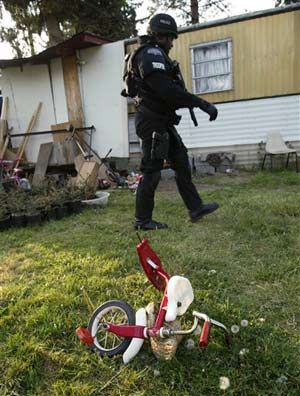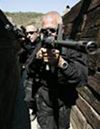By Rachel Fretz, Police1 editor
A Colorado paper recently ran the headline, “Drug raid nabs wrong woman,” followed by the subhead, “Intended target was next door.”
According to the Durango Herald report, “Law enforcement officers raided the wrong house and forced a 77-year-old
Hundreds of raids go right every day. A few, however, go wrong.
 (AP Photo/Karie Hamilton) |
This type of incident roils the public and puts agencies on the defensive, to put it mildly. (Think of the case of the 92-year-old
Given the potential repercussions of breaking down the wrong door, the safest course of action is to do the footwork: proper pre-raid planning.
“Most things that can go wrong fall into two categories,” said Dave Spaulding, 28-year veteran of the Montgomery County Sheriff’s Office in Ohio, and former commander of a multi-jurisdictional narcotics task force that was involved in several nationwide investigations and was considered a model for similar task force operations.
He identified the two categories as:
1) You’ve identified the wrong place to hit; or
2) Oversights are made during execution.
Identifying the right location
“Pre-raid reconnaissance is not always tactical,” Spaulding said. “Mostly you’ll want to look to make sure that the information you’ve received fits with your pre-raid intelligence.”
Spaulding recalls pre-raid planning done by his task force on a meth lab a few years back. An informant had tipped them off to a location where a “large quantity” of the drug was supposedly being produced.
“But when we drove by the condo, it was tiny,” he said. “You could tell the location and the reported quantity didn’t jibe.”
And after working surveillance on the property and noting very little foot traffic, which given the purported size of the operation should have been very apparent, the investigators knew it didn’t look right.
In fact, they had the right guy, but the wrong place. Eventually, they followed the suspect into the country, where there was plenty of space for a large-scale meth operation. Sure enough, the lab was there and they made the bust.
“Any time you’re given information from an outside source, you want to do everything you can to confirm it,” Spaulding said.
This is especially true when you’re dealing with criminal informants — either the paid variety or those working off a case — whose motives and personal implications don’t always lend themselves to telling the truth, especially to a cop.
Plus, regardless of whether or not a CI is reliable, he might not be sober. So it’s doubly important to verify what the CI tells you through independent observation.
“This isn’t as easy as it sounds,” said Ralph Mroz, Training Director of the Police Officer’s Safety Association. “Obviously, multiple buys by multiple CIs in the same place is great. That will help you verify whether or not their info is consistent.”
Another optimal situation is to have a CI introduce an undercover cop into the operation. This way, you have an officer there when he’s making the buys — someone who knows what to look for — and you also have verification of what the CI is telling you.
“Keep an eye out,” Mroz said. “Make sure you have even more intelligence in locations or parts of town that you’re not very familiar with.”
 (AP Photo/Karie Hamilton) |
To this end, pre-raid photography or videos are highly recommended. This way, everyone gets a visual of what they should be looking for.
Also, make sure that everyone knows where they are supposed to be prior to entry. “This helps reduce ‘friendly fire’ incidents and makes sure that all needed tasks are covered,” Spaulding said.
Spaulding also added that above all, it’s best to have a standard procedure for raid planning. “My task force had a set of forms with all of the tasks listed in a fill-in-the-blanks format to make sure ‘all bases’ were covered,” he said.
But intelligence is only one aspect of pre-raid planning. Then there’s the matter of double checking the address in the heat of the moment.
Oversights
When teams get the wrong information in regards to location, usually inattention to detail is to blame. This is usually a result of haste — a “We need to go now” attitude.
Assumptions are also to blame, for instance, the assumption that all members of the task force share the same level of familiarity with a neighborhood. This may happen in small- to mid-sized communities, where locations may be announced in an informal or abbreviated manner (e.g., “The old Singer family house on the corner of 5th”).
Be specific: Make sure you always have at least two descriptors of the place to be hit. For example, the address and the color of the door, or the address and what’s to the left and right of the door.
Always take the possibility of human error into account, as well. “One thing I have found is that it is easy to overlook small mistakes,” Spaulding said. “Your unit wants to hit the apartment at ‘2121-B Elm Street,’ but a typo when the search warrant is typed says ‘2121-C.’”
“Another such error would be to mix up the numbers: The team, based on surveillance, decides that ‘5231 Maple Street’ is the target house, but the warrant gets typed out as ‘5213.’”
This is especially true where multiple locations will be hit simultaneously.
“The lead investigator will be very busy in a case like this,” Spaulding said, “which means that the unit supervisor must be extra-vigilant to look for such things. Check and double check the facts and information. I have seen small mistakes like this become big problems.”
Spaulding also cited these common oversights: The door is more fortified than they thought/or the informant led them to believe, their understanding of the interior layout is not as planned, i.e. they did not know there was a basement, etc.
“And of course, there is always the risk of armed confrontation, which will occur at extreme close quarters,” he said.
Most “small mistakes” are usually the result of haste. The vast majority of cops want to take bad guys off the street and they hate to see cases fall apart this way. This type of mistake usually only happens once.
Lastly, Spaulding reminds us of Murphy’s Law: “If it can go wrong, it will.”
“All the more reason to cross-check as much as possible prior to forcing an entry,” he said.
Because everything matters...even the small stuff.
|
PRE-RAID CHECKLIST
Make sure all members of the team see a photo or video of the location. Make sure everyone knows where they’re supposed to be prior to entry. Independently verify information the CI has given. Make sure your intelligence jibes with reports. Check and double check all numbers/coordinates of the location. Be explicit with all task force members; do not make assumptions. Determine how you can be certain it is the right place once you’re at the door. |



